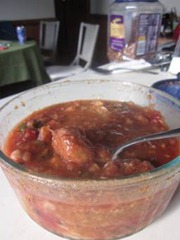Check it out. It didn’t take two months for me to post.
I’m getting good at this.
Also, I really hope that one day I look back at these blog posts and realize how BAD my pictures were, as in, I get BETTER.
(one can dream)
People always talk about chicken and dumplings.
I have no idea what that is. I never ate it as a kid…or a teen…or a college student.
To be honest, the concept of dumplings kinda confuses me, especially because the first time that I looked up what they were, the recipe literally said flour, salt, water.
????
However, I did find this awesome looking recipe on A Cozy Kitchen for Tomato soup with herb dumplings. Cute blog, good recipes, check it out.
But this soup caught my attention for a few reasons
· I had everything just lying around for it (major plus)
· It incorporated chickpeas (protein is always good)
· The dumplings contained WAY more than just flour (cheese and herbs!!!)
I played with the recipe a bit by adding more spices and some chard that we had from our CSA.
The end result was a pretty good tasting soup, but I learned I know NOTHING about dumplings.
In fact they turned out kinda like mushy balls of herby cheese flour. If you poke them too hard they disintegrate into the soup...which made it thicker….I guess that’s a plus?
What did I do wrong?
Maybe you know?
Anyways, it’s filling and tastes good, but next time I either need to figure out what this dumpling deal is or just stick to my usual piece of bread with soup.
Hearty Tomato and Herb Dumpling Soup
Adapted from the Cozy Kitchen
Soup
1 tablespoon olive oil
1 small onion, chopped
2 cloves garlic, crushed
½ teaspoon ground coriander
2 teaspoon cumin
1 teaspoon chili powder
1 can chickpeas, drained and rinsed
1 ¾ cup vegetable stock
1 14oz can chopped tomatoes
1 cup chopped chard (optional)
Dumplings
1 cup all purpose flour (I used half whole wheat)
1 ½ teaspoons baking powder
½ teaspoon salt
2 tablespoons butter, chopped
2 tablespoons grated Parmesan cheese
2 tablespoons chopped fresh herbs ( Thyme, Chives, Rosemary, your choice)
3 tablespoons water
Heat the oil over medium-high heat in a large saucepan and sauté the onion for 2-3 minutes or until soft. Add the garlic, cumin, coriander and chili powder and cook for 1 minute. Add the stock and tomatoes and blend with an immersion blender (or anything that blends, I used a food processor and only blended half to keep some of the chunkyness)
Stir in the chickpeas and bring to a boil. Once it boils reduce the heat and simmer, covered, for 10 minutes.
To make the dumplings, sift together the flour, baking powder and salt. Add in the chopped butter and knead with your fingers until the mixture starts to resemble fine bread crumbs. Stir in the cheese and herbs, and then make a well in the center of the mixture. Add in the water and mix together
Divide the dough into 8 portions and roll into small balls. Add the dumplings to the soup, cover and simmer for 20 more minutes.
If you know anything about dumplings, I’d suggest trying it out! I loved the idea but I would have liked a better result.
Happy cooking!
Leah


















